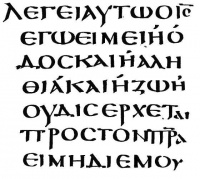Codex Petropolitanus Purpureus
From Textus Receptus
for the similarly named manuscript see Codex Petropolitanus (New Testament)
Codex Petropolitanus Purpureus, designed by N or 022 (in the Gregory-Aland numbering), ε 19 (Soden), is a 6th century Greek New Testament codex gospel book. Written in majuscules (capital letters), on 227 parchment leaves, measuring 32 x 27 cm. Paleographically it had been assigned to the 6th century.<ref name=Aland>Kurt Aland and Barbara Aland, The Text of the New Testament: An Introduction to the Critical Editions and to the Theory and Practice of Modern Textual Criticism, 1995, Grand Rapids, Michigan, p. 113. </ref>
Contents |
Description
It contains text of the four Gospels with a large number of lacunae.<ref name = Aland/> The manuscript text is in two columns, 16 lines, 12 letters in line, in large uncial letters. The lettering is in silver ink on vellum dyed purple, with gold ink for nomina sacra (ΙΣ, ΘΣ, ΚΣ, ΥΣ, and ΣΩΤΗΡ). It has errors of itacisms, as the change of ι and ει, αι and ε.<ref name = Gregory/>
Before the Gospels placed teh tables of κεφαλαια. Text is divided according to κεφαλαια. At the top of the pages τίτλοι preserved. The Ammonian sections and the Eusebian Canons are presented in the margin.<ref name = Gregory/> Texts of Luke 22:43-44, and John 7:53–8:11 are omitted.
The text is of the Byzantine text-type in a very early stage, with numerous Allien readings. According to Scrivener "it exhibits strong Alexandrian forms".<ref>Frederick Henry Ambrose Scrivener, A Plain Introduction to the Criticism of the New Testament, George Bell & Sons: London 1894, vol. 1, p. 141. </ref> According to Streeter in some parts it has the Caesarean redings. Aland placed it in Category V,<ref name=Aland/> and it is certain that it is more Byzantine than anything else.
Lacunae
Gospel of Matthew 1:1-24, 2:7-20, 3:4-6:24, 7:15-8:1, 8:24-31, 10:28-11:3, 12:40-13:4, 13:33-41, 14:6-22, 15:14-31, 16:7-18:5, 18:26-19:6, 19:13-20:6, 21:19-26:57, 26:65-27:26, 26:34-end;
Gospel of Mark 1:1-5:20. 7:4-20, 8:32-9:1, 10:43-11:7, 12:19-24:25, 15:23-33, 15:42-16:20;
Gospel of Luke 1:1-2:23, 4:3-19, 4:26-35, 4:42-5:12, 5:33-9:7, 9:21-28, 9:36-58, 10:4-12, 10:35-11:14, 11:23-12:12, 12:21-29, 18:32-19:17, 20:30-21:22, 22:49-57, 23:41-24:13, 24:21-39, 24:49-end;
Gospel of John 1:1-21, 1:39-2:6, 3:30-4:5, 5:3-10, 5:19-26, 6:49-57, 9:33-14:2, 14:11-15:14, 15:22-16:15, 20:23-25, 20:28-30, 21:20-end.
History
It is understood that the manuscript originated in the imperial scriptorium of Constantinople and was dismembered by crusaders in the 12th century. In 1896 Nicholas II of Russia commissioned Fyodor Uspensky's Russian Archaeological Institute to buy the greater part of it for the Imperial Public Library in St. Petersburg.<ref name = Gregory>C. R. Gregory, "Textkritik des Neuen Testaments", Leipzig 1900, vol. 1, p. 56-58. </ref><ref>Bruce M. Metzger, The Text of the New Testament: Its Transmission, Corruption and Restoration, 1968 etc, Oxford University Press, pp. 54-55. </ref> The codex was examined by Lambeck, Montfaucon, Treschow, Alter, Hartel, Wickholf, Bianchini, Duchesne.
Wettstein in 1715 examined 4 leaves housed at London (Cotton Titus C. XV). Wettstein cited only 5 of its readings. According to Scrivener it has 57 various readings.<ref>Scrivener F. H. A., A Full and Exact Collation of About 20 Greek Manuscripts of the Holy Gospels (Cambridge and London, 1852), p. XL. </ref><ref>Frederick Henry Ambrose Scrivener, A Plain Introduction to the Criticism of the New Testament, George Bell & Sons: London 1894, vol. 1, pp. 139-140. </ref> Treschow in 1773 and Alter in 1787 had given imperfect collations of Vienna fragments.<ref>F. K. Alter, Novum Testamentum Graecum, ad Codicen Vindobonensem Graece expressum: Varietam Lectionis addidit Franciscus Carolus Alter, 1 vol., Vienna, 999-1001.</ref> Lambeck gave wrong suggestion that Vienna fragments and Vienna Genesis originally belonged to the same codex.<ref>Lambeck, Commentariorum de aug. bibliotheca Caesar. Vinob. ed. alt. opera et studio Adami Franc. Kollarii, Wien, Bd. (Buch) 3 (l776), col. 30-32. </ref><ref name = Gregory/>
Tischendorf published fragments of this manuscript in 1846 in his Monumenta sacra et profana. Tischendorf considered it as fragment of the same codex as 6 leaves from Vatican, and 2 leaves from Vienna.<ref>F. H. A. Scrivener, A Full and Exact Collation of About 20 Greek Manuscripts of the Holy Gospels (Cambridge and London, 1852), p. XL.</ref>
The 231 extant folios of the manuscript are kept in different libraries: 182 leaves in Saint Petersburg, Russia, 33 leaves on the Isle of Patmos, Greece, the rest in Rome (6), London (4 folios)<ref>They were named the Codex Cottonianus. </ref>, Vienna (2), New York (1), and Athens (1), and Lerma (1), Greece.
Codex Petropolitanus Purpureus, along with the manuscripts Φ, O, and Σ, belongs to the group of the Purple Uncials.
A facsimile of all fragments was published 2002 in Athens.
See also
References
<references/>
External links
- Codex Petropolitanus Purpureus N (022) at the Encyclopedia of Textual Criticism
- Codex Petropolitanus Purpureus at the Evangelical Criticism
Further reading
- Constantin von Tischendorf, „Monumenta sacra inedita“ (Leipzig, 1846), pp. 15-24.
- S. P. Tregelles, "An Introduction to the Critical study and Knowledge of the Holy Scriptures", London 1856, pp. 177-178.
- F. H. A. Scrivener, A Full and Exact Collation of About 20 Greek Manuscripts of the Holy Gospels (Cambridge and London, 1852), p. XL. (as j)
- H. S. Cronin, "Codex Purpureus Petropolitanus. The text of Codex N of the gospels edited with an introduction and an appendix", T & S, vol. 5, no. 4 (Cambridge, 1899).
- C. R. Gregory, "Textkritik des Neuen Testaments", Leipzig 1900, vol. 1, pp. 56-59.

